产权视角下乡村闲置土地空间治理策略思考
关于闲置土地处置工作的思考与建议

关于闲置土地处置工作的思考与建议摘要:随着全球城市化的加速,如何有效利用土地受到各级政府的关注,然而,多年来,由于土地利用模式的混乱以及土地利用结构的欠缺,造成了大量的低效用地和闲置土地。
通过有效利用低效用地,并严格按照相关规定妥善处理闲置土地,可以大大促进节约和集约使用,从而提升土地利用效率。
面对当前日益增长的用地需求和严格的土地供应限制,盘活利用低效用地和闲置土地从而提高土地利用效率来促进当地经济和社会的可持续发展已成为不可回避的重要任务。
基于此,本文将对闲置土地处置工作的对策进行分析。
关键词:闲置土地;处置工作;思考与建议1闲置土地资源的利用现状当前,我国经济高速发展,城镇化进程不断加快,很多人因为农村教育、医疗、收益等方面的落后而选择离开,去往城市生活。
一方面,农村劳动人口减少使大量耕地荒废,粮食减产。
另一方面,从农村离开的人往往不会把农村的房屋拆除,而是选择将其保留,很多村庄因为人少而不得不进行合并,导致村委会、学校等地被闲置,这也促使农村闲置土地数量增加。
低效用地和闲置土地的利用往往很难,甚至不会产生社会经济效益,严重制约了当地经济的长期可持续发展。
农村闲置土地增加,粮食和农作物减产,农业生产总值降低,农民收入来源减少,不利于农村经济的长期发展。
土地闲置不仅浪费了宝贵的土地资源,同时也加剧了人地矛盾。
土地一旦被闲置,农业生产停止,土地抗侵蚀能力就会减弱,土地质量下降。
如果发生自然灾害,土地的生产功能就会受到损失,同时影响周边正常的土地资源,严重破坏生态环境,给农业生产带来很大的危害。
农民外出导致农村宅基地被闲置,部分地区甚至出现了“空心村”。
“空心村”的出现不仅使宅基地闲置,还使农村工矿仓储用地、基础设施用地、公共管理与公共服务用地、商服用地等用地闲置,导致更多的土地资源浪费。
土地利用不充分、设施废弃、景致荒凉,这些都与实现景观雅致、生活富裕、生态宜居的乡村振兴目标相违背。
当前我国土地规划中存在土地使用管理制度不健全、土地利用规划预见性不足、土地利用规划的方法有待提高以及闲置土地存在流转途径等问题2闲置土地开发利用原则2.1 准确分类原则导致我国农村土地闲置现状的情况有很多,闲置土地的原因往往包含许多方面,例如:农民外出打工,导致耕地荒废,或没及时流转;还有部分农民将土地流转到种粮大户后,由于其管理不善,最终导致土地闲置;大部分农村学生都选择去城市里上学,导致一些农村小学被荒废;有些则是用于水利、交通、灌溉水面等。
农村闲置土地现状及解决办法

关于农村土地闲置的思考Thinking of idle status about rural land[摘要]土地是一种珍贵而稀缺的资源,而我国又是一个人多地少的国家,土地后备资源不足是我国的基本国情,而我国却有大量土地闲置。
农业持续健康发展是三大产业稳定发展的基础,也是建设社会义主义和谐社会的必备条件,毕竟,民以食为天。
在“三农”中,农业是农村、农民存在的前提,没有农业,自然就没有了农村和农民的概念,解决“三农”问题归根结底、追本溯源就是搞好农业。
[关键词]农村农民农业土地闲置原因对策收入价格市场经济需求激励闲置土地的定义及对闲置土地处理相关法律法规闲置土地是指空闲搁置而未及时利用的土地。
根据我国1999年国土资源部出台的《闲置土地处理办法》,第二条之规定:闲置土地,是指土地使用者依法取得士地使用权后,未经原批准用地的人民政府同意,超过规定的期限未动工开发建设的建设用地。
我国现行的土地管理法律法规对闲置土地做了很多的规定,可是为什么闲置土地的数量还是居高不下呢?本文将阐述闲置土地的概念、相关的法律法规,并分析土地闲置的原因,提出自己对加强闲置土地管理的相关建议。
农村土地闲置的原因农村大面积耕地闲置,归根结底是种地所得的收入不高而且远不如干其他工作所得的,由市场经济的调节可以知道,人们将流向能满足自己最大需求的行业中去。
我国的市场经济的持续繁荣和发展,社会多元化越来越深入,在这样的大背景下,农民的收入渠道也越来越多,当然,我所在镇也不例外,人们可以通过外出打工或者经营生意等多种方式来改善自身的经济条件,种粮已不再是农民唯一的收入来源,加上年头不好等诸多因素的作用就削弱了农民的种地积极性。
【1】出外务工。
国内经济快速发展,特别是工业进步较快,需要大量的劳动力,农民有了更多的就业渠道,大量的涌入城市,降低了农民对土地的依赖。
每年,我国出外打工的人主要来自于农村,特别是七十年代,八十年代的农村青年,中学毕业后选择的都是出外打工之路。
关于闲置土地处置工作的思考与建议

关于闲置土地处置工作的思考与建议_垒工研奔与摄索随着我国工业化,城市化步伐的加快,土地供需矛盾日益突出,保护耕地,规范城市开发建设用地的使用,已成为各级领导关心,人民群众关注的焦点.但另一方面,一段时期以来,建设用地"粗放式"利用甚至造成闲置,仍是我国不少地区土地使用过程中的痼疾.因此,在经济发展仍需要大量土地作支撑的现阶段,加大对闲置土地的处理力度,盘活存量用地,提高土地集约节约利用水平,已成为当前各级政府土地管理工作中的一项重要内容.由于土地闲置情况复杂,涉及面广,影响力大.处理不当,容易引发新的经济其他原因造成的.1,动拆迁困难当前,拆迁难已经成为阻碍城市建设和经济发展的主要难题之一一些项目的土地出让手续早已办理,但随着房地产市场持续升温,动迁居民对安置补偿要求不断提高.动拆迁的难度也在日益加大.一些实力较弱的开发商因无力承担不断上涨的动拆迁成本,无法在规定的期限内完成房屋拆迁,导致项目无法开工建设,已批土地处于闲置状态.目前,我区由动拆迁矛盾而导致的土地闲置占全部闲置土地的比重较大.3,开发商自身因素2002年以前.土地供应以毛地出让为主.大部分地块出让金相比现在的招拍挂要发商可以较小的成本取得土it种供地方式常常使一些资金强,开发能力不足的企业也刨与地块的开发建设.现在这商取得土地后,如果一旦遇至困难或市场形势下滑等情况,因自有资金或开发经验不足,不放缓开发建设的进程.甚j开发,造成土地闲置.也有少娄商刻意囤积土地,待土地升机再动,实现以"时间换金钱"问题和社会稳定问题.因此在处置闲置土地的过程中,既要做到依法行政,又要兼顾经济可持续发展.本文拟结合基层单位在实际处理闲置土地过程中遇到的问题.就如何进一步依法加强对闲置土地的管理和处置.作初步探讨.土地闲置的成因较为复杂.往往是多种因素综合作用的结果.去年本市的一份调查研究报告显示, 上海目前的闲置土地大致有三种类型.其中,属于动拆迁因素的占41%, 规划调整引发的占29%,另有30%是由于开发商资金不足,债权纠纷等202,城市规划调整在经济快速发展的过程中,政府部门的很多法规政策都会因客观形势和条件的变化而相应调整.例如.土地出让方面,经营性项目用地由原先的协议出让转变为招拍挂出让:规划方面,改变了以往高容积率政策.实施了"双增双降".政策的更新必然带来城市功能和规划的调整.由此也不可避免地影响到土地的开发建设,造成一定程度的土地闲置.实践中,有的项目虽已列入实施计划.但因政府产业导向等发生变更.致使整体规划需要调整,进而影响了原定项目方案的如期实施, 拖延了项目的开工建设.此外,如开发商与土地的合同纠纷,转让项目的债务纠纷,参建企业合作纠纷等,.吐发土地闲置的诸多原因.二,处理闲置土地中当前,土地闲置已引发了列社会问题和经济问题.各纫对闲置土地问题越来越重视,力度也越来越大.但由于土的情况错综复杂,相关的法徭又不健全,导致有关土地管霸在具体执法过程中,常常会趋方面的实际困难.I.实体性问题(1)关于执法主体的确认问题本市《闲置出让土地处置试行规定》中明确规定,市和区(县)土地管理部门按照"谁出让,谁处置"的原则,负责闲置土地的认定和处置工作.据此,由区(县)土地管理部门出让的闲置土地,应当由各区(县)局自行处置.但自去年以来,市,区房地部门在行政执法方面作了具体分工:凡涉及土地方面的行政执法工作.全部由市房地资源局负责直接实施.由此,在处理闲置土地方面,区f县)房地部门究竟有无执法权,还需市房地部门进一步明确.(2)关于处罚对象的认定问题闲置土地的处罚对象,应为经行政主管部门合法登记,土地权利证书上载明的土地使用权人.实践中.有的土地使用者私下签定项目转让协议,却未到政府土地管理部门办理相应的土地使用权变更登记手续,致使土地的实际使用人发生了变化,而法律意义上土地使用权人却未变更.对于这种情况,笔者认为.一旦发生土地闲置现象,违法用地的处罚对象,仍然应该是原登记单位为主体.(3)关于土地闲置的界定问题对于闲置土地的界定,笔者认为,除法律,法规规定的情况外,还应当包括虽已动工,但未按合同约定开发建设等情形.如:有的土地使用者,虽已对土地进行开发建设,但仅在地块上搭建一些临时性厂棚; 也有的土地使用者.办理非农业建设项目占用耕地的审批手续后,仍由农民作耕地使用,且1年以上未动工建设的.对于这些情况,因为合同约定的开发项目未作实质启动,均应视作土地闲置.此外,对闲置土地的界定还应有细化标准.根据《闲置出让土地处置试行规定》,已开工建设的土地,如果动工面积不足应开发建设总面积的1/3:或用于地上建筑物的投资额不足总投资额的硼究与探索S垒垒l工I25%,仍可认定为闲置土地.笔者认为,此条款不十分明确,执行起来有一定难度.比如:实际开发建设的面积是以开发商提供的图纸为准,还是以测绘部门实地测量的结果为准:开发商提供的投资报表,是否可以直接作为认定依据,还是必须经有资质的审价机构审定等等.这些问题.都应在相关的实施细则中作进一步细化和明确,以方便操作. (4)关于处罚金额的确定问题国土资源部《闲置土地处置办法》中规定,超过出让合同约定的动工期满1年未动工开发的,可以征收土地使用权出让金20%以下的土地闲置费.本市2000年前出让的土地中,有相当一部分是划拨土地,未缴纳土地出让金,对于这部分土地中存在的土地闲置现象,如何收取土地闲置费相关法规政策未作明确规定. 另一方面,该规章以20%出让金作为土地闲置费的收缴上限,对收缴下限未作规定,这就赋予了地方土地管理部门较大的自由裁量权.实践经验表明,自由裁量范围过大既不利于操作,也容易引发执法上的随意性. (5)关于"准闲置土地"的处置问题实践中,还有相当一部分的闲置土地.并非完全表现为法律法规所规定的情形.本市的一份调查研究报告显示,有的土地使用者并未取得土地使用权,但却获得了政府同意其使用土地的准许并实际占有了土地.最后由于该土地使用者的原因致使土地被闲置;有的开发商取得土地后,虽已完成同~宗地部分土地的开发建设,但又存在着相当比例的土地低效利用或处,闲置状态.统计数据表明,目前这些类型闲置土地的I幕,5撬簪了关法规中规.f稀警蔑.0对}{:..,{1于这韦甥埋柳监管,还有待从立法上加以研究解决.2.程序性问题…一…(1)关于土地闲置的起算时间I司题土地闲置是一个持续状态.对于起算时间,根据本市《闲置出让土地处置试行规定》,以土地出让合同中约定的动工日期为准:合同中没有约定的.从合同生效满一年起算. 笔者认为,合同生效满一年并不等同于具备了开工条件.从签约到最后开工,其中还有一个不可预见的时问段.项目能否按期开工,除开发商自身原因外,还取决于规划用地许可证,可行性批复等一系列前期审批手续能否在规定时间内办妥.故对土地闲置的起算时间不应"一刀切",应作具体情况,具体分析.建议将土地闲置的起算时间,调整为"自具备开工条件起".(2)关于是否举行听证问题对于征收土地闲置费之前是否要进行听证,目前有关方面的观点也不统一.一种观点认为,征收土地闲置费.属于行政事业性收费,而并非行政处罚.所以并不要求土地管理部门在收取闲置费前告知听证.近日发生在广东省东莞市的一起因征收土地闲置费引发的行政诉讼案件中,一审法院就支持了上述观点.另一种观点认为,征收土地闲置费,是土地管理部门对违反土地管理法律,法规的相对人,依法采取的惩戒行为,属于典型的行政处罚;且因罚款数额巨大,依据《行政处罚法》必须事先举行听证.笔者认为,行政事业性收费是基于社会公共管理和服务的需要,由国家向特定对象收取的费用,并不带有警示或惩罚目的;征收土_她闲置费是为督促建设草位枣并i莱或的翻措施,带有咀显的处罚性质.所以,征收土蛀釜苗点尧全禾同手祷政事业性收费,其本质上应定性为行政罚苏,,按照有关规定必须在实施前举行听证.21_H垒H垒!I研究与摄索到的实际问题,现就进一步依法加强闲置土地处置工作,提高土地集约节约利用水平,提出如下建议. 1.完善相关的法律法规随着形势的发展,土地闲置的表现和特点正不断发生变化.处理闲置土地的要求也在不断提高.因此.必须按照新形势的要求,不断完善法律法规.用新的思路和办法来解决土地闲置问题.建议在《土地管理法》,国土资源部《闲置土地处置办法》,以及本市《闲置出让土地处置试行规定》的基础上,制定具体的实施意见或操作流程.将有关闲置土地的处置规定进一步细化,量化和深化,从立法上进一步明确闲置土地的认定标准,执法程序以及相关行政部门应承担的职责等内容, 从而为治理和防范闲置土地.规范土地市场秩序,创造一个良好的法制环境.2.针对具体情况研究制定处置方案土地闲置的原因非常复杂,在制定闲置土地的处置方案时,要对每一个个案的具体情况作具体分析.研究针对性办法.如:对于动拆迁引发的土地闲置.政府部门应深入一线.加强对拆迁工作的指导,协调.并在裁决,强迁方面予以大力支持.推进地块的动拆迁任务尽快完成对于规划调整引发的土地闲置, 如原开发商有能力按新规划要求继续开发建设的.应尽快办理相关调整手续,督促开发商尽快开工:反之,则应对开发商作相应补偿后,由政府依法收回土地,并将地块重新招拍挂出让.对因开发资金不足引发的土地闲置.要在政府有关部门的指导和协调下.通过依法转让土地使用权,引入有实力的开发商,推进项目尽快启动.对于闲置年数较长,一时难以盘活的土地.可由政府收回后作储备土地.并可用于建造临时停车场等公益性设施,待日后条件成熟后再返还开发商或另行处置.3.营造依法用地的良好舆论氛围要充分发挥电视,广播,报刊,网络等媒体的作用,多渠道宣传土地管理法律法规,闲置土地的危害,依法查处闲置土地的重要意义等,进一步增强全社会科学用地,合理用地,节约集约用地的意识.努力形成珍惜土地的良好社会氛围.同时,建议定期通过媒体将闲置土地的处置情况向社会公开,依靠行政和社会的双重监督.减少土地闲置现象.4.加强土地管理信息化建设要充分借助计算机技术,提高对闲置土地的处置效率和监管水平.建议在调查摸底的基础上,建立闲置土地管理信息系统,将闲置土地的地址,开发单位,开发项目,闲置时间,闲置原因等基础信息,全部纳入系统实行统一管理和动态监测,并通过基层土地巡查.定期更新系统数据.此外,区分闲置满一年, 满两年,将闲置而未闲置等不同情况.设置相应的预警指标体系,分级判定其闲置状态,并对不同的状态对应采取不同的管理措施.由此,真正通过信息技术,提高工作效率,实现对闲置土地的"精细化"监管. 5,充分发挥街道(镇)在处置闲置土地中的作用闲置土地问题涉及面广,危害性大.沉淀矛盾多.处置闲置土地不仅是土地管理部门的职责,也是地方政府的责任.除行政主管部门外, 闲置土地所在的镇政府,街道办事处,也应当按照"条块结合,属地管理"的运作机制,共同参与闲置土地的调查取证和协助处置.特别是在政策宣传,矛盾化解等方面,地区部门要切实发挥块上的综合协调作用,促进社区和谐发展.通过条块联动,齐抓共管,凝聚各部门工作合力,有力,有序地推进闲置土地处置工作.6.强化建设用地全过程管理处置闲置土地是一项全局性,长期性,系统性的工作.为更有效地清理闲置土地,要着眼长远,防治结合,将闲置土地处置工作贯穿于土地管理的全过程.一是强化源头管理.要按照"节约集约用地"的指导思想,科学编制土地利用总体规划和年度用地计划,对新建项目首先考虑利用现有存量土地(特别是批而未供,供而未用的土地),从源头上把好土地出让的闸门.二是加强批后监督.土地出让后,要深化批后管理和跟踪监督,通过实地走访,项目年检等途径,及时了解项目开发进展情况,有闲置苗头的.及时纠正,坚决制止.三是加大执法力度. 在闲置土地认定以后.要严格按照有关规定.收取土地闲置费.甚至收回土地,体现土地执法的权威性和严肃性随着社会和经济的发展.必须加大对闲置土地的处置力度.包括运用经济和行政的强势措施.当然, 处置闲置土地不能等同于加强收费,还应当综合分析土地闲置的原因.采取积极措施,妥善解决动拆迁,规划调整等问题,从根本上消除引发土地闲置的各类矛盾,使土地资源在新时期得到更科学,更有效, 更合理地利用,服务于经济社会的又好又快发展.(作者单位:上海市普陀区房屋土地管理局)同。
试析农村闲置土地利用与管理的对策

试析农村闲置土地利用与管理的对策摘要:近年来,随着我国产业结构的调整和城市化进程的加快,农村大量劳动力从土地中解放出来转入第二和第三产业中,农村也相应出现了不同程度的土地闲置现象。
土地作为民生之本,其利用与管理关乎着国家发展和社会财富的增长,其影响深远。
我国的耕地资源稀缺,但承载人口众多,面临着人多地少的矛盾。
土地闲置则进一步加剧了这一问题,出现土地市场混乱、耕地非农化的趋势,对后代生存发展产生了极大威胁。
关键词:农村;闲置土地;利用与管理;对策;成因近年来,我国农村出现了大面积的闲置土地,在当前耕地减少、人口增长、人地矛盾日益突出的环境下,对农村社会经济产生着不利影响,也威胁到了我国粮食安全。
我国作为一个农业大国,土地对于经济发展有着重要意义,但受人口影响我国人均耕地面积较少,但同时农村土地闲置现象却广泛存在,大量土地资源被浪费。
因此,当前需要重视起这一问题,采取有效措施来解决。
1. 闲置土地概述1.1闲置土地含义当前,国内外对闲置土地含义的界定主要有两种。
首先是国土资源部中明确指出的,闲置土地指的是在土地使用者依法取得使用权后,在未经过原批准用地人民政府同意的情况下,超过规定期还没有进行动工开发建设的用地。
闲置土地也包含以下几种情形:第一,在土地资源的国有土地有偿使用合同和建设用地批准书中,没有对开发建设日期进行规定,而在该合同和批准书颁发之日起满一年未开发建设的土地;第二,土地已动工开发建设,但其面积没有达到该土地开发建设面积的三分之一,或者已开发建设投资额占总投资额不足25%,并且这些情况下没有经过批准将其开发建设活动中止,且其已达到一年或以上时间的情况;第三,在一些法律法规和行政法规中规定的其它相关情形。
1.2土地闲置的危害性(1)土地闲置会影响到粮食产量,当前我国大量农用耕地被闲置,使得人地矛盾更加突出,而当前农民缺乏耕种积极性,当前的农业生产活动中,主要采取的是粗放式经营模式,会严重影响到粮食种植面积。
对闲置土地问题的思考与建议

对闲置土地问题的思考与建议摘要:我国基本国情之一是人多地少、耕地后备资源不足、人地矛盾突出,因而合理节约配置土地资源是国土资源管理工作中的一项紧迫任务。
当下我国工业化和城市化步入快速发展时期,建设用地却呈现出供需紧张和闲置浪费并存的局面。
关键词:闲置土地工业化建设用地一、闲置土地的界定处置闲置土地意味着土地资源的再利用,也直接关系到相对人的宪法基木权利(财产权),为此必须对闲置土地概念的基本外延作出准确界定。
现行法律法规,如《土地管理法》第37条、《城市房地产管理法》第23条、《城镇国有土地使用权出让和转让暂行条例》第17条、《字昌建省实施(土地管理法>办法》(以下简称《实施办法》)第46条以及1999年国上资源部第5号令《闲置土地处置办法》(以下简称《处置办法》),都对闲置行为作了明确的禁止性规定。
那么应该如何在理论上“界定”闲置地呢?笔者认为,至少以下几种情形应认定为闲置土地。
第一,在物权法意义上取得土地使用权,也就是用地批准文件、有偿使用合同生效,用地人已支付相应对价,人民政府供给上地并办理登记,土地使用人取得上地使用权后超规定时限未开发的。
第二,用地批文、有偿使用合同生效,用地人已按约支付对价,人民政府供给上地但米办理登记。
对此情形我们认为上地使用人取得土地使用权是一种客观的事实状态,因为登记只是一种公示行为,土地使用权的取得是通过审批或合同协议而来,米办理登记只是缺少了处分权,并不影响开发建设,所以这时超出规定期限开发,是受使用者主观意思支配而实施的行为,其性质仍属闲置。
二、闲置土地产生原因虽然,现实中造成土地闲置的原因以及遭遇处置难的困境是多方面的,但笔者认为,就自身角度作为市场规则制订者和维护者的政府及管理部门而言,市场机制的缺位、法律体系的缺陷、管理理念的陈旧以及技术手段的落后是问题的根本。
就闲置土地产生原因而言,一是宏观机制层面的市场机制缺位是引发土地闲置的根本原因。
由于前些年市场机制在土地资源配置领域作用未能得到有效发挥,加之在地方政府推动型的经济增长模式作用下,土地自身的价值规律和价格杠杆作用被人为扭曲,政府供应价与市场交易价之间存在的价差,成为了用地主体寻租行为的利益驱动,直接导致了用地主体的用地成本意识低下,从根本上形成了企业圈占滥占土地,造成土地闲置的内在动因。
浅谈对农村空置宅基地问题管理的分析与思考

浅谈对农村空置宅基地问题管理的分析与思考摘要:城市化建设的不断推进,使得我国农村很多地区不同程度地存在“空心村”和“一户多宅”的现象,严重浪费土地资源。
针对这一情况,国家曾经明确指出,“建设用地包括农村集体建设用地和宅基地,要控制增量,盘活存量,提高土地利用效率和集约化程度”。
因此必须加强对农村空置宅基地进行有效管理。
基于此,本文阐述了农村空置宅基地的主要特征,对农村空置宅基地问题管理的分析与思考进行了探讨,旨在加强对农村空置宅基地进行管理。
关键词:农村空置宅基地;特征;问题;管理;分析;思考随着城市化进程加快以及社会经济的发展,大量农村人口从农村迁往城市,如村民外出务工、子女求学定居城市等,使得大量农村空置宅基地得不到有效处理。
这样不但增加了国土部门对空置宅基地的管理难度、浪费了土地资源,也对当地经济的快速发展产生影响。
以下就农村空置宅基地问题管理的分析与思考进行探讨。
一、农村空置宅基地的主要特征农村空置宅基地的特征主要表现为:(1)通常出现在经济欠发达的地区。
这些地区交通不便,没有形成自己独特的致富之路,大量人员长久外出务工,致使大量房屋长期空置;(2)分布散乱的特征。
农村空置宅基地一般都是杂乱无章散布于村庄各处;(3)空置宅基地与宅基地需求矛盾突出的特征。
按照现行法律,只要有新的农户产生,该户人家就有权得到一块宅基地。
但法律没有规定子女继承房产后不得另占有宅基地,继承后的空置宅基地大量涌现;(4)不可流转性特征。
法律规定农村宅基地只能在本集体成员之间流转,非本集体成员不得对宅基地进行交易。
二、农村空置宅基地问题管理的分析1、农村空置宅基地引发的社会问题。
(1)浪费土地资源的问题。
第一、大量农村闲置宅基地的存在,造成了土地资源的巨大浪费,极不利于农业的可持续发展;第二、废弃宅基地一一荒草连片、残垣废墟、鼠蛇猖撅破坏了农庄优美的人居生态环境。
(2)空置宅基地杂乱无章的局面引发一系列农村治安问题。
乡村振兴背景下关于闲置宅基地整治思考
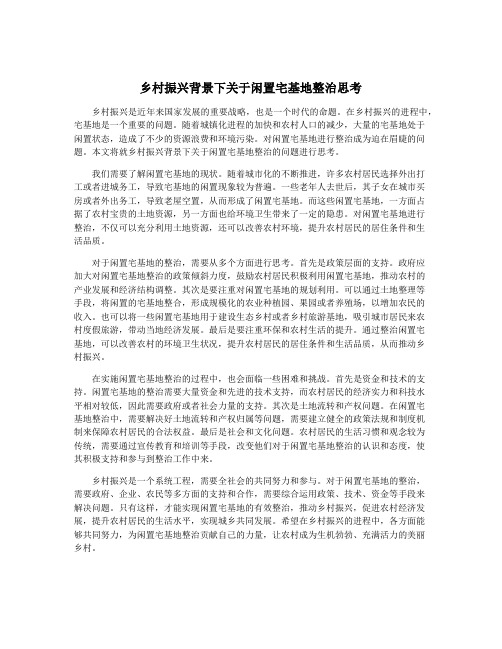
乡村振兴背景下关于闲置宅基地整治思考乡村振兴是近年来国家发展的重要战略,也是一个时代的命题。
在乡村振兴的进程中,宅基地是一个重要的问题。
随着城镇化进程的加快和农村人口的减少,大量的宅基地处于闲置状态,造成了不少的资源浪费和环境污染。
对闲置宅基地进行整治成为迫在眉睫的问题。
本文将就乡村振兴背景下关于闲置宅基地整治的问题进行思考。
我们需要了解闲置宅基地的现状。
随着城市化的不断推进,许多农村居民选择外出打工或者进城务工,导致宅基地的闲置现象较为普遍。
一些老年人去世后,其子女在城市买房或者外出务工,导致老屋空置,从而形成了闲置宅基地。
而这些闲置宅基地,一方面占据了农村宝贵的土地资源,另一方面也给环境卫生带来了一定的隐患。
对闲置宅基地进行整治,不仅可以充分利用土地资源,还可以改善农村环境,提升农村居民的居住条件和生活品质。
对于闲置宅基地的整治,需要从多个方面进行思考。
首先是政策层面的支持。
政府应加大对闲置宅基地整治的政策倾斜力度,鼓励农村居民积极利用闲置宅基地,推动农村的产业发展和经济结构调整。
其次是要注重对闲置宅基地的规划利用。
可以通过土地整理等手段,将闲置的宅基地整合,形成规模化的农业种植园、果园或者养殖场,以增加农民的收入。
也可以将一些闲置宅基地用于建设生态乡村或者乡村旅游基地,吸引城市居民来农村度假旅游,带动当地经济发展。
最后是要注重环保和农村生活的提升。
通过整治闲置宅基地,可以改善农村的环境卫生状况,提升农村居民的居住条件和生活品质,从而推动乡村振兴。
在实施闲置宅基地整治的过程中,也会面临一些困难和挑战。
首先是资金和技术的支持。
闲置宅基地的整治需要大量资金和先进的技术支持,而农村居民的经济实力和科技水平相对较低,因此需要政府或者社会力量的支持。
其次是土地流转和产权问题。
在闲置宅基地整治中,需要解决好土地流转和产权归属等问题,需要建立健全的政策法规和制度机制来保障农村居民的合法权益。
最后是社会和文化问题。
对闲置土地问题的思考
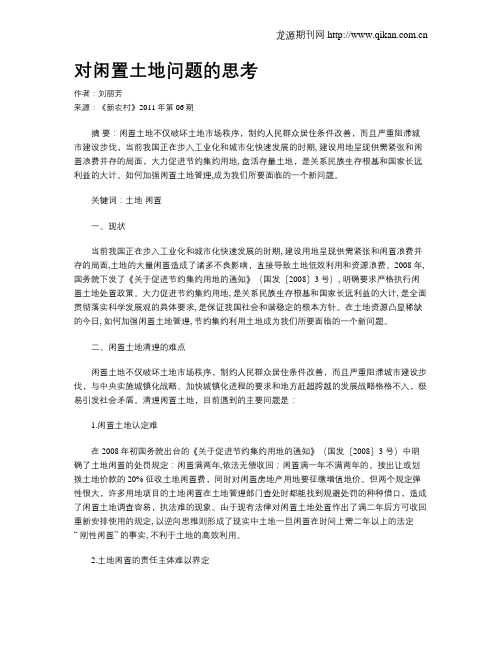
对闲置土地问题的思考作者:刘丽芳来源:《新农村》2011年第06期摘要:闲置土地不仅破坏土地市场秩序,制约人民群众居住条件改善,而且严重阻滞城市建设步伐,当前我国正在步入工业化和城市化快速发展的时期, 建设用地呈现供需紧张和闲置浪费并存的局面,大力促进节约集约用地, 盘活存量土地,是关系民族生存根基和国家长远利益的大计。
如何加强闲置土地管理,成为我们所要面临的一个新问题。
关键词:土地闲置一、现状当前我国正在步入工业化和城市化快速发展的时期, 建设用地呈现供需紧张和闲置浪费并存的局面,土地的大量闲置造成了诸多不良影响,直接导致土地低效利用和资源浪费。
2008 年, 国务院下发了《关于促进节约集约用地的通知》(国发〔2008〕3号), 明确要求严格执行闲置土地处置政策。
大力促进节约集约用地, 是关系民族生存根基和国家长远利益的大计, 是全面贯彻落实科学发展观的具体要求, 是保证我国社会和谐稳定的根本方针。
在土地资源凸显稀缺的今日, 如何加强闲置土地管理, 节约集约利用土地成为我们所要面临的一个新问题。
二、闲置土地清理的难点闲置土地不仅破坏土地市场秩序,制约人民群众居住条件改善,而且严重阻滞城市建设步伐,与中央实施城镇化战略、加快城镇化进程的要求和地方赶超跨越的发展战略格格不入,极易引发社会矛盾。
清理闲置土地,目前遇到的主要问题是:1.闲置土地认定难在2008年初国务院出台的《关于促进节约集约用地的通知》(国发〔2008〕3 号)中明确了土地闲置的处罚规定:闲置满两年,依法无偿收回;闲置满一年不满两年的,按出让或划拨土地价款的20% 征收土地闲置费,同时对闲置房地产用地要征缴增值地价。
但两个规定弹性很大,许多用地项目的土地闲置在土地管理部门查处时都能找到规避处罚的种种借口,造成了闲置土地调查容易,执法难的现象。
由于现有法律对闲置土地处置作出了满二年后方可收回重新安排使用的规定, 以逆向思维则形成了现实中土地一旦闲置在时间上需二年以上的法定“ 刚性闲置” 的事实, 不利于土地的高效利用。
低效用地和闲置土地利用盘活的对策思考

低效用地和闲置土地利用盘活的对策思考摘要:近年来,随着我国社会经济的快速发展,土地资源紧张问题更加凸显,为提升土地资源利用率,需要积极盘活低效用地,同时依法处置闲置土地。
这是缓解用地紧张问题的有效措施,是保障地方经济健康发展的必然选择。
基于此,本文分析了当前低效用地和闲置土地利用盘活面临的主要问题,并就相关对策进行探究,仅供大家参考。
关键词:低效用地;闲置土地;利用盘活;对策引言:在用地需求强劲以及土地供给刚性制约的背景下,如何提升土地资源利用率已经成为影响经济发展的重要问题。
为缓解用地紧张和提升土地资源利用率,应加强低效用地和闲置土地利用盘活,这对促进土地利用率提升以及推动地区经济健康发展具有十分重要的意义。
因此要结合低效用地和闲置土地现状,经济探索更加有效的对策,缓解土地资源紧张带来的社会压力。
1低效用地和闲置土地带来的负面影响1.1不利于经济发展低效用地和闲置土地的利用率较低,通常情况下难以产生较大的经济效益,甚至不会带来经济效益,造成严重的资源浪费,同时低效用地和闲置土地还会占据地区建设用地总规模,影响新增建设用地计划指标分配,使得新增建设用地指标不足,一些重点项目无法顺利开展。
由此可见,低效用地和闲置土地会给当地经济发展带来十分不利的影响。
1.2不利于城镇化发展近年来,我国城镇化推进速度相对较快,但是由于低效用地和闲置土地的存在,会给这一进程带来负面影响。
地方针对低效用地和闲置土地的利用缺乏有效措施,通常只能采用回购收储的方式调作他用,在这种情况下,会使得城镇化的成本大幅度提升,因此会在很大程度上制约城镇化的发展。
1.3不利于空间开发低效用地和闲置土地导致土地资源利用率偏低,用地效益也会随之下降。
与此同时,低效用地和闲置土地还会占用建设用地指标,这种情况会造成房价不断提升,给人们的购房带来巨大压力,同时也会对社会的发展带来不利影响。
2低效用地和闲置土地利用盘活存在的问题及原因分析2.1存在的主要问题2.1.1底数不清目前,针对低效用地和闲置土地的认定尚未形成统一的规范标准,再加之受历史变革以及遗留问题的影响,使得低效用地和闲置土地统计结果缺乏可靠性。
对我国闲置土地若干问题的研究与思考
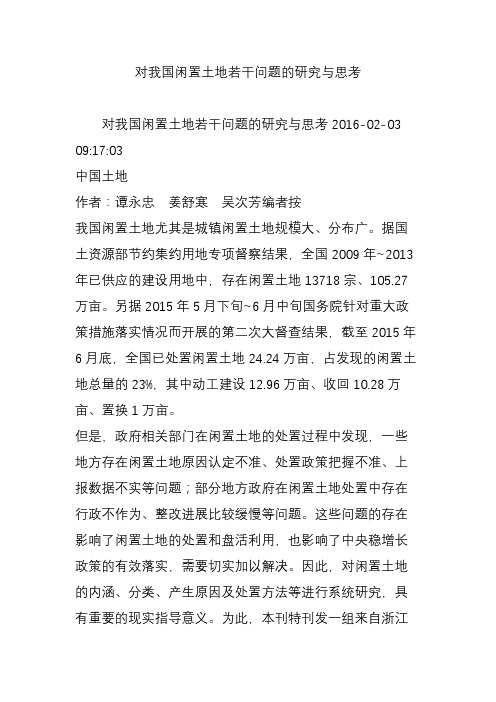
对我国闲置土地若干问题的研究与思考对我国闲置土地若干问题的研究与思考2016-02-03 09:17:03中国土地作者:谭永忠姜舒寒吴次芳编者按我国闲置土地尤其是城镇闲置土地规模大、分布广。
据国土资源部节约集约用地专项督察结果,全国2009年~2013年已供应的建设用地中,存在闲置土地13718宗、105.27万亩。
另据2015年5月下旬~6月中旬国务院针对重大政策措施落实情况而开展的第二次大督查结果,截至2015年6月底,全国已处置闲置土地24.24万亩,占发现的闲置土地总量的23%,其中动工建设12.96万亩、收回10.28万亩、置换1万亩。
但是,政府相关部门在闲置土地的处置过程中发现,一些地方存在闲置土地原因认定不准、处置政策把握不准、上报数据不实等问题;部分地方政府在闲置土地处置中存在行政不作为、整改进展比较缓慢等问题。
这些问题的存在影响了闲置土地的处置和盘活利用,也影响了中央稳增长政策的有效落实,需要切实加以解决。
因此,对闲置土地的内涵、分类、产生原因及处置方法等进行系统研究,具有重要的现实指导意义。
为此,本刊特刊发一组来自浙江大学土地与国家发展研究院对于闲置土地处置的研究报告,以期为加强我国闲置土地的管理和处置提供参考。
闲置土地的处置难点与治理路径闲置土地的产生原因错综复杂,涉及行政、制度、价格、税收、市场、文化和规划等各方面的因素。
在当前的制度环境下,我国对闲置土地的处理主要有以下几种方式:①征收土地闲置费;②延期开发;③政府采取招标、拍卖等方式确定新的土地使用者,对原建设项目继续开发建设,并对原土地使用者给予补偿;④政府为土地使用者置换其他等价闲置土地或者现有建设用地进行开发建设;⑤土地使用者将土地使用权交还给政府,并取得适当的补偿;⑥依法收回闲置土地使用权。
这些方法都可对已产生的闲置土地进行处理,但很多方法在管理部门具体实施时难以开展,造成现阶段土地闲置量大、处理难的问题。
因此,应制定切实可行的政策,进行制度改革,从根源上预防闲置土地产生。
对闲置土地处置工作的认识和思考

对闲置土地处置工作的认识和思考摘要:土地闲置问题由来已久,已成为土地管理工作中难以根除的“顽疾”之一。
2018年实施“增存挂钩”政策以来,在连续4年“批而未供和闲置土地消化处置双降15%”的强压态势下,各级政府均高度重视,多数因政府方面原因制约开工建设问题得到了有效解决,闲置土地数量有所减少。
但仍有一定数量的闲置土地因存在缺少政策执行依据、整体情况复杂、成因时效以及主观意愿分歧等问题导致处置工作一时无从人手。
本文从闲置土地处置实际出发,通过分析闲置土地一般和特殊成因,以问题为导向探寻处置路径。
关键词:闲置土地;处置工作;认识与思考前言:近年来,我国土地资源紧缺、土地供需矛盾突出,同时,土地粗放浪费现象依然严重,闲置土地大量涌现。
因此,研究解决闲置土地问题,提高土地利用效率,能够加强对土地的利用和保护,从而更加有效地支撑经济发展,闲置土地处置已成为当前国土资源利用和管理的重点工作。
1闲置土地的定义闲置土地,狭义上是指根据《闲置土地处置办法》第二条规定,国有建设用地使用权人超过土地出让合同或者划拨决定书约定、规定的动工开发日期满一年未动工开发的国有建设用地,以及已动工开发但开发建设用地面积占应动工开发建设用地总面积不足1/3或者已投资额占总投资额不足25%,中止开发建设满一年的国有建设用地。
广义上,闲置土地,即土地使用权人开发建设超过闲置土地认定标准,但又未达到节约集约利用的土地,如开发建设已超过1/3,但未达到合同容积率的用地;厂房全部建成,但因企业效益不佳、濒临破产,或虽正常生产但亩均税收不高的土地等,这也是地方政府眼中的闲置土地。
2闲置土地处置的意义十分珍惜、合理利用土地和切实保护耕地是我国的基本国策。
在解决土地供求矛盾中,发挥存量潜力、善用闲置土地具有十分重要的意义。
要促进城乡建设健康发展,必须充分发挥土地利用总体规划的整体管控作用,落实最严格的耕地保护制度,健全完善耕地保护补偿机制,确保耕地数量不减少、质量有提升、生态有改善。
乡村振兴背景下关于闲置宅基地整治思考

乡村振兴背景下关于闲置宅基地整治思考近年来,乡村振兴战略成为我国经济社会发展的重要内容。
随着城市化进程的加快,大量农村居民迁徙到城市,导致乡村地区出现了大量的闲置宅基地。
这些闲置宅基地的存在不仅浪费了土地资源,也使得乡村的土地利用效率降低,甚至成为了乡村环境的一大隐患。
对于闲置宅基地的整治已经成为了当前乡村振兴工作的重要内容之一。
本文将就乡村振兴背景下关于闲置宅基地整治进行一些思考。
一、闲置宅基地存在的问题我们需要认识到闲置宅基地存在的一些问题。
大量闲置宅基地不仅占用了大量土地资源,而且这些宅基地周围通常还会伴随着一些乱搭乱建、垃圾堆积等现象,严重影响了乡村的环境卫生。
这些闲置宅基地也给乡村的规划建设带来了一定的困难,使得乡村的土地利用效率大大降低,影响了乡村整体的发展。
如何有效地整治这些闲置宅基地成为了当前乡村挑战的一大难题。
二、闲置宅基地整治的思路针对闲置宅基地存在的问题,我们需要对整治思路进行一些探讨。
应该注重加强宅基地的管理。
通过成立乡村宅基地管理委员会,建立健全乡村宅基地管理制度,加强宅基地的规划管理,规范宅基地的使用,确保土地资源的合理利用。
还可以鼓励村民自愿把闲置宅基地整合起来,形成规模更大、建设更合理的宅基地使用,提高土地的利用效率。
可以通过发挥宅基地的综合效益,增加宅基地的经济价值。
除了住宅外,宅基地还可以发挥农业、旅游等多种功能,增加宅基地的综合效益。
通过开发宅基地周围的其他农业资源,推动农村产业的发展,实现宅基地的多功能利用,提高宅基地的经济价值。
还可以通过政府引导和扶持的方式,推动闲置宅基地的整治。
政府可以出台相关政策,对于闲置宅基地的整治给予一定的补贴或者税收优惠,鼓励村民积极参与宅基地整治工作。
还可以加大对于宅基地整治项目的扶持力度,为农村提供更多的支持和协助,推动整治工作的开展。
闲置宅基地整治工作也面临着一些挑战。
由于闲置宅基地通常分散分布在农村地区,宅基地整治的规模较大,不同地区的情况也各不相同,这就增加了整治工作的难度。
浅析农村闲散土地盘活利用的问题与对策

浅析农村闲散土地盘活利用的问题与对策摘要:长期以来,我国农村土地资源开发利用面临着严重的问题,如宅基地废弃、村庄周边土地闲置未利用、坑塘沟渠荒废等,各种各样情况数量都不在少数,这些土地长期未得到合理开发利用,成为农村发展中亟待解决的问题。
关键词:农村闲散土地;盘活利用;问题与对策引言:随着大量农村居民进入城市发展,很多村民的宅基地被长期闲置,废弃院子、坑塘等问题越来越多,一些地区甚至出现了“空心村”,造成了土地资源的浪费,严重制约了经济社会发展。
文章通过对当前农村闲散土地盘活利用中存在的问题进行分析,针对性的提出一些对策建议来促进农村闲散土地盘活利用。
一、农村闲散土地盘活利用的意义(一)农村闲散土地的含义农村闲散土地是指废弃的农村宅基地、工矿仓储用地、坑塘沟渠等或者布局散乱、利用粗放的集体建设用地以及村庄周边可开发利用的未利用地等。
由于经济快速发展,城市扩张,大量的农村人口迁入城市,很多土地没有开垦或者利用,造成土地资源的闲置和浪费。
(二)盘活利用的意义民族复兴离不开乡村振兴,在推进乡村振兴的大背量下,农村闲散土地作为重要的自然资源,是乡村振兴的重要载体。
农村闲散土地的盘活利用直接关系到村集体的切身利益,可以缓解村庄用地供需矛盾,优化利用结构,甚者可以直接带动村集体发展,对促进乡村的全面振兴和农村经济的可持续发展有重要意义。
二、农村闲散土地存在的问题以及原因分析(一)存在的问题1、闲散土地布局散乱。
很长时间以来,由于没有科学全面的乡村规划,造成了大量的闲散土地分布支离零散、面积小,成片聚集利用不现实。
有些乡村还存在一户多宅、宅基地占地过大、建新不拆旧等违反政策的问题;一些废弃房屋、场院、道路、坑塘等村集体未充分利用,被村民、单位无偿使用堆放杂物或违反土地性质使用,环境脏乱,不仅影响了村庄的面貌,有悖于新农村建设要求,还可能存在安全隐患,也浪费了土地资源,堵塞了村集体收入的渠道。
2、闲散土地盘活利用的既得收益欠佳。
解析法学视角下闲置土地的政府干预和市场化策略
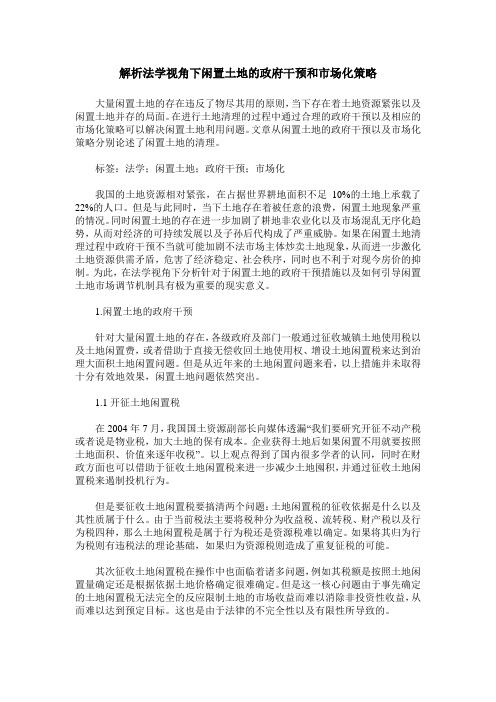
解析法学视角下闲置土地的政府干预和市场化策略大量闲置土地的存在违反了物尽其用的原则,当下存在着土地资源紧张以及闲置土地并存的局面。
在进行土地清理的过程中通过合理的政府干预以及相应的市场化策略可以解决闲置土地利用问题。
文章从闲置土地的政府干预以及市场化策略分别论述了闲置土地的清理。
标签:法学;闲置土地;政府干预;市场化我国的土地资源相对紧张,在占据世界耕地面积不足10%的土地上承载了22%的人口。
但是与此同时,当下土地存在着被任意的浪费,闲置土地现象严重的情况。
同时闲置土地的存在进一步加剧了耕地非农业化以及市场混乱无序化趋势,从而对经济的可持续发展以及子孙后代构成了严重威胁。
如果在闲置土地清理过程中政府干预不当就可能加剧不法市场主体炒卖土地现象,从而进一步激化土地资源供需矛盾,危害了经济稳定、社会秩序,同时也不利于对现今房价的抑制。
为此,在法学视角下分析针对于闲置土地的政府干预措施以及如何引导闲置土地市场调节机制具有极为重要的现实意义。
1.闲置土地的政府干预针对大量闲置土地的存在,各级政府及部门一般通过征收城镇土地使用税以及土地闲置费,或者借助于直接无偿收回土地使用权、增设土地闲置税来达到治理大面积土地闲置问题。
但是从近年来的土地闲置问题来看,以上措施并未取得十分有效地效果,闲置土地问题依然突出。
1.1开征土地闲置税在2004年7月,我国国土资源副部长向媒体透漏“我们要研究开征不动产税或者说是物业税,加大土地的保有成本。
企业获得土地后如果闲置不用就要按照土地面积、价值来逐年收税”。
以上观点得到了国内很多学者的认同,同时在财政方面也可以借助于征收土地闲置税来进一步减少土地囤积,并通过征收土地闲置税来遏制投机行为。
但是要征收土地闲置税要搞清两个问题:土地闲置税的征收依据是什么以及其性质属于什么。
由于当前税法主要将税种分为收益税、流转税、财产税以及行为税四种,那么土地闲置税是属于行为税还是资源税难以确定。
闲置土地科学开发利用的实践和思考
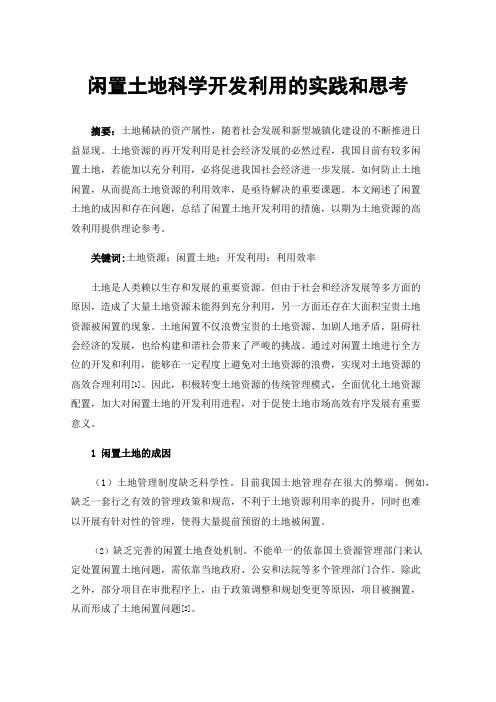
闲置土地科学开发利用的实践和思考摘要:土地稀缺的资产属性,随着社会发展和新型城镇化建设的不断推进日益显现。
土地资源的再开发利用是社会经济发展的必然过程,我国目前有较多闲置土地,若能加以充分利用,必将促进我国社会经济进一步发展。
如何防止土地闲置,从而提高土地资源的利用效率,是亟待解决的重要课题。
本文阐述了闲置土地的成因和存在问题,总结了闲置土地开发利用的措施,以期为土地资源的高效利用提供理论参考。
关键词:土地资源;闲置土地;开发利用;利用效率土地是人类赖以生存和发展的重要资源。
但由于社会和经济发展等多方面的原因,造成了大量土地资源未能得到充分利用,另一方面还存在大面积宝贵土地资源被闲置的现象。
土地闲置不仅浪费宝贵的土地资源、加剧人地矛盾,阻碍社会经济的发展,也给构建和谐社会带来了严峻的挑战。
通过对闲置土地进行全方位的开发和利用,能够在一定程度上避免对土地资源的浪费,实现对土地资源的高效合理利用[1]。
因此,积极转变土地资源的传统管理模式,全面优化土地资源配置,加大对闲置土地的开发利用进程,对于促使土地市场高效有序发展有重要意义。
1闲置土地的成因(1)土地管理制度缺乏科学性。
目前我国土地管理存在很大的弊端。
例如,缺乏一套行之有效的管理政策和规范,不利于土地资源利用率的提升,同时也难以开展有针对性的管理,使得大量提前预留的土地被闲置。
(2)缺乏完善的闲置土地查处机制。
不能单一的依靠国土资源管理部门来认定处置闲置土地问题,需依靠当地政府、公安和法院等多个管理部门合作。
除此之外,部分项目在审批程序上,由于政策调整和规划变更等原因,项目被搁置,从而形成了土地闲置问题[2]。
(3)供需矛盾频繁出现。
由于一些项目缺少建设用地的指标,无法向用地单位供地,导致一些建设项目搁置。
此外,在征地过程中,人们对土地价格设定、利益分配方案和补偿标准等问题存在异议,影响和干扰了征地工作,导致政府无法如期供地,造成不少建设用地闲置。
乡村振兴背景下关于闲置宅基地整治思考
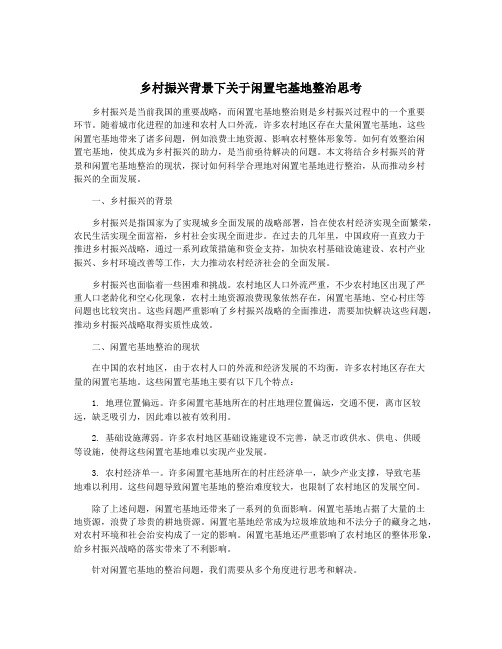
乡村振兴背景下关于闲置宅基地整治思考乡村振兴是当前我国的重要战略,而闲置宅基地整治则是乡村振兴过程中的一个重要环节。
随着城市化进程的加速和农村人口外流,许多农村地区存在大量闲置宅基地,这些闲置宅基地带来了诸多问题,例如浪费土地资源、影响农村整体形象等。
如何有效整治闲置宅基地,使其成为乡村振兴的助力,是当前亟待解决的问题。
本文将结合乡村振兴的背景和闲置宅基地整治的现状,探讨如何科学合理地对闲置宅基地进行整治,从而推动乡村振兴的全面发展。
一、乡村振兴的背景乡村振兴是指国家为了实现城乡全面发展的战略部署,旨在使农村经济实现全面繁荣,农民生活实现全面富裕,乡村社会实现全面进步。
在过去的几年里,中国政府一直致力于推进乡村振兴战略,通过一系列政策措施和资金支持,加快农村基础设施建设、农村产业振兴、乡村环境改善等工作,大力推动农村经济社会的全面发展。
乡村振兴也面临着一些困难和挑战。
农村地区人口外流严重,不少农村地区出现了严重人口老龄化和空心化现象,农村土地资源浪费现象依然存在,闲置宅基地、空心村庄等问题也比较突出。
这些问题严重影响了乡村振兴战略的全面推进,需要加快解决这些问题,推动乡村振兴战略取得实质性成效。
二、闲置宅基地整治的现状在中国的农村地区,由于农村人口的外流和经济发展的不均衡,许多农村地区存在大量的闲置宅基地。
这些闲置宅基地主要有以下几个特点:1. 地理位置偏远。
许多闲置宅基地所在的村庄地理位置偏远,交通不便,离市区较远,缺乏吸引力,因此难以被有效利用。
2. 基础设施薄弱。
许多农村地区基础设施建设不完善,缺乏市政供水、供电、供暖等设施,使得这些闲置宅基地难以实现产业发展。
3. 农村经济单一。
许多闲置宅基地所在的村庄经济单一,缺少产业支撑,导致宅基地难以利用。
这些问题导致闲置宅基地的整治难度较大,也限制了农村地区的发展空间。
除了上述问题,闲置宅基地还带来了一系列的负面影响。
闲置宅基地占据了大量的土地资源,浪费了珍贵的耕地资源。
产权视角下乡村闲置土地空间治理策略思考
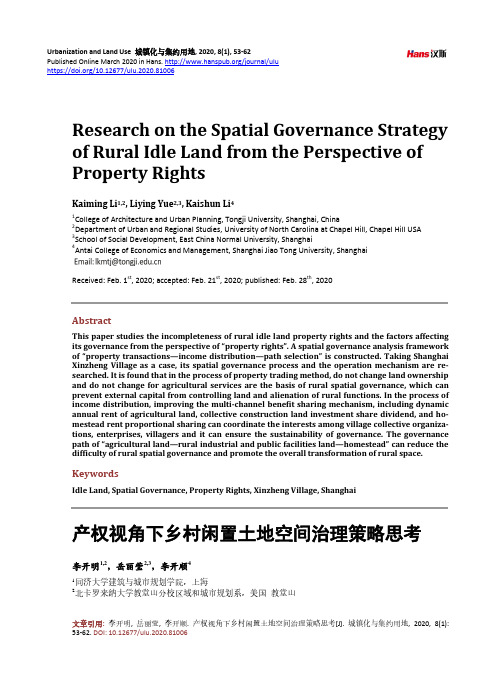
Urbanization and Land Use 城镇化与集约用地, 2020, 8(1), 53-62Published Online March 2020 in Hans. /journal/uluhttps:///10.12677/ulu.2020.81006Research on the Spatial Governance Strategy of Rural Idle Land from the Perspective ofProperty RightsKaiming Li1,2, Liying Yue2,3, Kaishun Li41College of Architecture and Urban Planning, Tongji University, Shanghai, China2Department of Urban and Regional Studies, University of North Carolina at Chapel Hill, Chapel Hill USA3School of Social Development, East China Normal University, Shanghai4Antai College of Economics and Management, Shanghai Jiao Tong University, ShanghaiReceived: Feb. 1st, 2020; accepted: Feb. 21st, 2020; published: Feb. 28th, 2020AbstractThis paper studies the incompleteness of rural idle land property rights and the factors affecting its governance from the perspective of “property rights”. A spatial governance analysis framework of “property transactions—income distribution—path selection” is constructed. Taking Shanghai Xinzheng Village as a case, its spatial governance process and the operation mechanism are re-searched. It is found that in the process of property trading method, do not change land ownership and do not change for agricultural services are the basis of rural spatial governance, which can prevent external capital from controlling land and alienation of rural functions. In the process of income distribution, improving the multi-channel benefit sharing mechanism, including dynamic annual rent of agricultural land, collective construction land investment share dividend, and ho-mestead rent proportional sharing can coordinate the interests among village collective organiza-tions, enterprises, villagers and it can ensure the sustainability of governance. The governance path of “agricultural land—rural industrial and public facilities land—homestead” can reduce the difficulty of rural spatial governance and promote the overall transformation of rural space.KeywordsIdle Land, Spatial Governance, Property Rights, Xinzheng Village, Shanghai产权视角下乡村闲置土地空间治理策略思考李开明1,2,岳丽莹2,3,李开顺41同济大学建筑与城市规划学院,上海2北卡罗来纳大学教堂山分校区域和城市规划系,美国教堂山李开明 等3华东师范大学社会发展学院,上海 4上海交通大学安泰经济与管理学院,上海收稿日期:2020年2月1日;录用日期:2020年2月21日;发布日期:2020年2月28日摘 要从“产权”出发,本文研究了乡村闲置土地产权的残缺性以及影响其空间治理的因素。
乡村振兴视角下农村闲置用地问题的探讨

三 农 论 坛农业开发与装备 2019年第11期乡村振兴视角下农村闲置用地问题的探讨杨秀琴(广东省社会科学院,广东广州 510610)摘要:在界定农村闲置用地的基础上,分析了农村存在大量闲置用地的状况与乡村振兴目标和要求的相悖之处,指出提高农民农业生产性补贴,推广轮作休耕制、推动闲置耕地流转、大力发展现代农业等是与乡村振兴相符的闲置耕地盘活方式;推进闲置宅基地复垦、开展闲置宅基地的多样化经营等是与乡村振兴相符的闲置宅基地盘活方式;结合美丽乡村建设、乡村产业振兴等用地需要盘活闲置二三产业用地,增强闲置用地产权流动性,鼓励闲置二三产业用地二次流转等是与乡村振兴相符的闲置二三产业用地盘活方式。
关键词:乡村振兴;农村闲置用地;盘活方式0 引言2017年10月党的十九大报告提出了乡村振兴战略,2018年1月中央一号文件全面提出了关于实施乡村振兴战略的意见,2018年3月国务院的《政府工作报告》再次强调大力实施乡村振兴战略,2018年9月中共中央国务院印发了《乡村振兴战略规划(2018-2022年)》,并要求各地区各部门结合实际认真贯彻落实。
中国正在紧锣密鼓实施的乡村振兴战略,离不开农村土地这一基本要素的支撑和保障。
但是多年来中国广大农村存在大量旧厂、旧宅、空心村甚至抛荒地、弃耕地等土地闲置的现象。
据统计,目前中国农村宅基地约有1 332万hm2(2亿亩),其中三分之一闲置[1],每年撂荒的耕地则近200万hm2(0.3亿亩)[2],农村土地资源闲置浪费问题极为严重。
既为了盘活农村大量闲置用地,也为了保障乡村振兴的用地需求,基于中国乡村振兴发展战略,剖析农村存在大量闲置用地的状况与乡村振兴目标和要求的相悖之处,探讨与乡村振兴相符的农村闲置用地盘活方式。
1 农村闲置用地的界定、分类及研究范围的界定在中国城镇化、工业化快速进程中,大量乡镇企业在市场竞争中被淘汰、农民不断增建住宅、许多农民进城务工等因素使中国农村闲置土地越来越多,关于农村土地闲置的研究也越来越多。
乡村振兴背景下关于闲置宅基地整治思考

乡村振兴背景下关于闲置宅基地整治思考近年来,乡村振兴战略成为国家发展的重要方向之一。
随着城市化进程的加速,许多农村居民选择离开家乡到城市谋生,而这些人留下了大量的闲置宅基地。
对于闲置宅基地的整治是乡村振兴过程中不可避免的问题之一,本文对这一问题进行了思考。
一、闲置宅基地整治的意义1. 利于资源的合理利用乡村闲置宅基地的整治,可以充分利用资源,挖掘其潜在价值,为乡村经济发展与提升乡村居民的生活品质提供支撑。
可以将废旧物品回收利用,提高利用效率,同时也能为环境保护做贡献。
2. 推动乡村经济发展随着闲置宅基地的整治,原有的不良影响逐渐淡化,闲置宅基地重新被赋予了新的价值。
这些地方可以建立新的工厂、企事业单位及新型农业,促进当地经济的发展,增加就业机会,提高农民的收入水平,增强乡村经济的发展实力。
3. 增强城乡一体化发展闲置宅基地整治是城乡一体化发展的重要内容之一。
整治过程中,可以充分融合城乡发展理念,发挥闲置宅基地的潜能,提高乡村基础设施建设和管理水平,推进农村建设与城市建设之间的互动,促进乡村与城市之间的良性循环。
1. 权属问题闲置宅基地的产权归属不清、分散、重复等问题较为普遍,要解决这一问题,需要多方面的协调,对于不合理的产权安排需要进行重新的合理分配。
2. 整治资金缺乏闲置宅基地整治过程中需要耗费大量资金,其中包括土地整理、环境治理、基础设施建设等方面的费用,然而,由于筹资渠道单一且资金不足,导致整治难以顺利进行。
3. 文化遗产问题乡村是中华文化的发源地之一,也是历史文化遗产丰富的地方,闲置宅基地的整治涉及到文化遗产保护的问题,要考虑历史文化背景以及文化保护政策,尽可能保护文化遗产。
1. 稳定产权对于闲置宅基地的产权,需要明确归属,并通过适当的法律手段保护其产权,加大宣传力度。
要依法进行收购和补偿,确保农民的利益不受损害。
在此基础上进行开发和利用,提高土地的价值。
2. 创新融资机制整治闲置宅基地需要一定的资金支持,因此需要创新融资机制,加强与投资方的合作,吸引社会力量和民间资本进入该领域。
- 1、下载文档前请自行甄别文档内容的完整性,平台不提供额外的编辑、内容补充、找答案等附加服务。
- 2、"仅部分预览"的文档,不可在线预览部分如存在完整性等问题,可反馈申请退款(可完整预览的文档不适用该条件!)。
- 3、如文档侵犯您的权益,请联系客服反馈,我们会尽快为您处理(人工客服工作时间:9:00-18:30)。
Urbanization and Land Use 城镇化与集约用地, 2020, 8(1), 53-62Published Online March 2020 in Hans. /journal/uluhttps:///10.12677/ulu.2020.81006Research on the Spatial Governance Strategy of Rural Idle Land from the Perspective ofProperty RightsKaiming Li1,2, Liying Yue2,3, Kaishun Li41College of Architecture and Urban Planning, Tongji University, Shanghai, China2Department of Urban and Regional Studies, University of North Carolina at Chapel Hill, Chapel Hill USA3School of Social Development, East China Normal University, Shanghai4Antai College of Economics and Management, Shanghai Jiao Tong University, ShanghaiReceived: Feb. 1st, 2020; accepted: Feb. 21st, 2020; published: Feb. 28th, 2020AbstractThis paper studies the incompleteness of rural idle land property rights and the factors affecting its governance from the perspective of “property rights”. A spatial governance analysis framework of “property transactions—income distribution—path selection” is constructed. Taking Shanghai Xinzheng Village as a case, its spatial governance process and the operation mechanism are re-searched. It is found that in the process of property trading method, do not change land ownership and do not change for agricultural services are the basis of rural spatial governance, which can prevent external capital from controlling land and alienation of rural functions. In the process of income distribution, improving the multi-channel benefit sharing mechanism, including dynamic annual rent of agricultural land, collective construction land investment share dividend, and ho-mestead rent proportional sharing can coordinate the interests among village collective organiza-tions, enterprises, villagers and it can ensure the sustainability of governance. The governance path of “agricultural land—rural industrial and public facilities land—homestead” can reduce the difficulty of rural spatial governance and promote the overall transformation of rural space.KeywordsIdle Land, Spatial Governance, Property Rights, Xinzheng Village, Shanghai产权视角下乡村闲置土地空间治理策略思考李开明1,2,岳丽莹2,3,李开顺41同济大学建筑与城市规划学院,上海2北卡罗来纳大学教堂山分校区域和城市规划系,美国教堂山李开明 等3华东师范大学社会发展学院,上海 4上海交通大学安泰经济与管理学院,上海收稿日期:2020年2月1日;录用日期:2020年2月21日;发布日期:2020年2月28日摘 要从“产权”出发,本文研究了乡村闲置土地产权的残缺性以及影响其空间治理的因素。
以上海市新征村为例,对其闲置土地空间治理历程和运作机制进行剖析。
研究发现,不改变土地所有权和不改变为农服务用途的产权交易策略是推动治理的基础,可防止外部资本控制土地,防止乡村功能的异化。
采用农用地动态年租金、集体建设土地出资入股分红、宅基地租金按比例共享等收益分配策略,构建了多渠道利益共享机制,可有效协调村集体组织、企业、村民的利益,保证治理的可持续性。
“农用地——乡村工业和公共设施用地——宅基地”形成了“由易及难”的治理路径策略,可有效降低治理成本,推动乡村农用地、建设用地的整体转型。
关键词闲置土地,空间治理,产权,新征村,上海Copyright © 2020 by author(s) and Hans Publishers Inc. This work is licensed under the Creative Commons Attribution International License (CC BY 4.0). /licenses/by/4.0/1. 引言改革开放以来,伴随着工业化、城镇化的快速发展,乡村人口的非农化转移带来乡村常住人口的逐渐减少[1]。
乡村集体土地管理制度和宅基地的福利分配功能,导致村民建房“建新不拆旧”,乡村建设用地出现了不减反增的倒挂现象,与此同时,乡村农用地也出现大面积撂荒现象,乡村土地呈现出集体建设用地和农用地的大量闲置。
在这种形势下,完善乡村闲置土地的空间治理[2],优化乡村空间结构,是改善乡村人居环境、实现乡村振兴的重要举措。
近年来围绕闲置土地空间治理,形成了减量规划和三旧改造两种模式。
减量规划是通过建设用地指标的“空间转移”完成城乡空间的集中布局和优化[3]。
三旧改造则利用地方政府土地新政,对闲置土地进行市场导向再开发。
从实施效果看,两者都缺乏对社会效益的充分关注,不利于乡村长远发展;乡村闲置建设用地减量后,村集体组织失去了土地,村民失去了就近工作机会,乡村缺乏进一步发展的动力;三旧改造中,其房地产导向的商业开发使乡村功能过度城市化[4]。
如何在乡村闲置用地的空间治理中,既能满足集约节约用地的目的,又能满足乡村涉农产业发展的用地需求,从而壮大村集体组织的实力,促进乡村的内生增长,是乡村闲置用地空间治理需要进一步考虑的问题。
本文分析了乡村闲置用地治理面临的难点,回顾了上海市新征村闲置土地空间治理过程,研究了其闲置用地的空间治理策略,以期为我国其他区域乡村闲置用地的治理提供借鉴。
2. 乡村闲置土地治理的难点2.1. 闲置土地与残缺的产权乡村闲置土地是指在一定时期内,未被使用的乡村土地[5]。
从用地构成来看即包含闲置农用地和闲李开明等置建设用地两种类型,其中集体建设用地可进一步细分为宅基地、乡镇工业用地、乡村公共设施用地[6]。
造成闲置的原因既有经济层面的要素,农业生产的低收入导致乡村劳动力放弃农田务农到城市务工[7];又有政策层面的因素,宅基地政策“无退出、无限期、无偿使用”的政策,地方政府监督不力,执法力度不强,导致的乡村建设用地违建现象[8];还有制度层面因素,我国宪法规定,乡村土地属于农民集体所有,所有集体经济组织的成员都是该闲置土地的所有权人。
在集体所有制的前提下,集体土地只能用于农业生产和生活,村集体组织无权将农地转变为建设用地发展非农经济[9]。
集体土地的出让、转让和抵押受到国家法律禁止,只有通过征地转换为国有用地,而难以直接入市经营;产权的残缺造成了集体土地产权主体不明、交易不畅等现象,造成了土地的闲置。
2.2. 国内外关于乡村闲置土地的研究由于我国农村土地产权的残缺性,导致乡村闲置土地是一个具有中国特色的问题。
国外关注乡村闲置土地的研究主要从土地利用集约化的角度,分析了乡村土地利用的格局变化和驱动要素,提出了通过土地管理政策和技术创新提高土地使用效率的方法[10][11]。
国内对乡村闲置土地的研究集中在成因、对策和实践分析三方面。
学者认为宅基地不能入市转让、地方政府监督执法不完善、城市化快速推进是导致我国乡村土地闲置的主要原因[12]。
据此,有学者提出完善乡村土地产权制度、完善乡村闲置土地利用法规、加快土地经营权流转等一系列措施[13][14]。
但这些措施涉及到国家层面土地制度的重大变革,在短时间内难以实现。
也有学者结合实际案例对乡村闲置学校、闲置庭院的利用策略进行了研究[15][16]。
但研究主要关注了乡村闲置建设用地,缺乏对乡村闲置农用地的关注。
因此,在我国现有乡村土地产权制度下,完善对乡村闲置建设用地和闲置农用地的治理策略研究,具有重要的现实意义。
2.3. 闲置土地空间治理的影响因素2.3.1. 产权交易方式为推动闲置土地的空间治理,需要推动产权交易,明晰其产权结构,其中产权起着关键的作用。
产权作为一项权利束,一般包括资源的所有权,资源的排他性使用权,通过使用资源而获取资金的收益权,以及通过出售或其他办法转让资源给他人的转让权[17]。
根据所有权变更的差异,闲置土地空间治理可以划分为二种模式。
一是所有权主体发生变更,即闲置集体土地转变为国有土地。
政府和市场获得了绝大部分土地增值收益,但是村集体组织失去了土地,乡村缺乏进一步发展的动力,实践不利于我国的乡村全面振兴。
